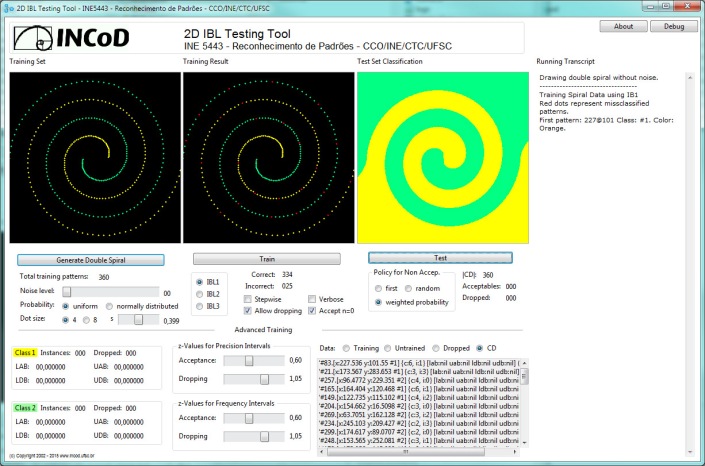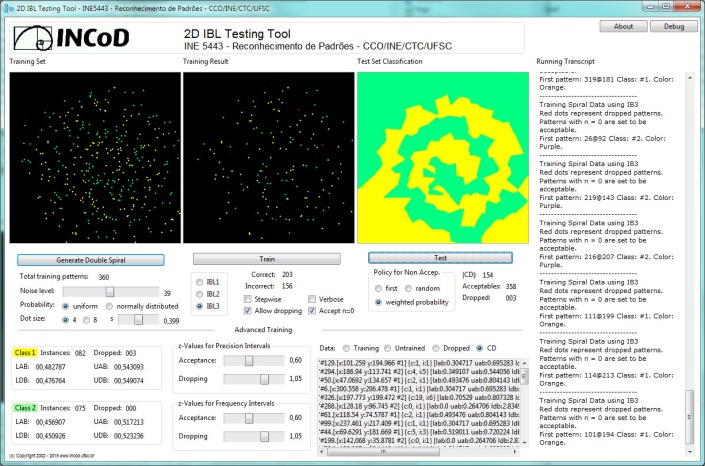IBLBrowser – A Machine Learning teaching Tool implementing the IBL Family
Este site em Português: http://www.lapix.ufsc.br/ensino/reconhecimento-de-padroes/iblbrowser-%E2%80%93-uma-ferramenta-de-aprendizado-de-maquina-que-implementa-a-familia-de-algoritmos-ibl
IBLBrowser description
This software was intended to help the teaching of ML algorithms. It was developed in Smalltalk in different, widely spaced, bursts of creativity between 2002 and 2015. It was developed with the intention to produce a tool to demonstrate the working of IBL algorithms and NOT done with any serious usability criteria in mind. The GUI is a patchwork of buttons, sliders and fields.
Take a deep breath and use it as it is! Alternatively, you can improve it and send me a copy of your efforts…
Background:
The software, in various incarnations, has been used since 2002 at the INE 5443 Reconhecimento de Padrões course (Pattern Recognition) held during the 7th semester of the undergrad CS Program at UFSC. It was intended to help teaching basic symbolic PR techniques on the example of traditional ML algorithms, such as the IB family.
IB1 without noise
IB3 with lots of noise
The Code:
- GitHub repository containing 3 versions of the application:
- the sources as a VisualWorks 8.0 package
- the sources as individual Smalltalk classes (Squeak programmers beware: this is Smalltalk source code with VisualWorks GUI class references…)
- a VisualWorks 8.0 32 bit image file (with .changes)
Comment: Why not Squeak? I’m a Smalltalk developer since the end of the 1980’s and my whole PhD, in the first half of the 1990’s, was developed in ParcPlace Objectworks Smalltalk. To use a Smalltalk dialect compatible with the original ParcPlace Smalltalk was, for me, an obvious design decision. So I opted for Cincom Smalltalk as the heir of ParcPlace Visualworks. I know it is a product and that it is not fully compatible with current free software Smalltalk implementations such as Squeak, but it was easier for me to do so as to use the Apollo/Domain Smalltalk 80 v 2.5 anno 1988-styled development interfaces of Squeak. I would be happy if someone ported this tool to Squeak and would make it available here also.
Usage:
1. Generating Training Data
You can generate double spiral datasets with and without noise. IBLBrowser always generates 360 points, 180 in each class.
The Noise Level is the maximum noise, expressed in pixels, to be used in the generation of the double spiral.
The Probability radio button chooses the Distribution used to generate noise for training patterns when noise is desired:
– uniform – random generator with the noise range value used directly (always expressed in pixels)
– normal – a normal distribution along the main curve with sigma of 0.399 and x in [0.0 0.5] is used.
The Sigma of the probability distribution used to generate the training patterns can be set with the slider, allowing to parametrize the scattering of the points.
2. Training with IBL
Presently you can train using IB1, IB2 or IB3 (IB4 and IB5 wouldn´t make sense for a domain of 2 classes with only two variables).
The IB version can be chosen with the radio button in the middle of the interface. Learned patterns will appear as dots of the chosen dotsize in the middle drawing area.
The first pattern included in the Concept Description will always be drawn in a different color, since it is randomly chosen and not trained. Position and color are displayed in the transcript area.
When training with IB1, wrongly classified patterns will appear as red dots, otherwise the color of the pertaining class will be used.
When training with IB2, the color used for each plotted pattern is the color of the correct class of each pattern (since only incorrectly classified patterns will be learned).
When training with IB3, dropped patterns will be recolored as red dots after they are dropped, so you can visualize where droppings occurred. Acceptance is caculated using z = 0.60. This value can be changed on the corresponding sliders.
3. Operating Modes when Training
There is a set of radio buttons that set operating modes and policies for the training process, mainly for IB3:
Stepwise – when in IB3, simulation halt after acceptable pattern and dropping (when selected) has occured.
Verbose – a log of the training steps is transcribed to the right text field (transcript). Will slow down considerably tthe training.
Allow dropping – bad classifiers are allowed to be dropped. Dropping PIs and FIs are set to use z = 0.90. This value can be changed on the corresponding sliders.
Accept n=0 – you can choose if patterns of the CD that were ever used before to classify something are acceptable as classification references for learning new patterns. Since their PIs would be infinite due to n=0, it is, in theory possible, but that is a question of interpretation. My personal experience is that learning gets biased when you ignore previously unused patterns.
Policy for Non Acceptance – sets the policy to be used when no acceptable pattern was found. There are the following policies:
– first – most similar pattern is chosen (can introduce bias)
– random – a random pattern is chosen from the CD
– weighted – a random pattern is chosen from the CD with class-weighted probabilities, so that roughly the probability of an instance of each class to be chosen is the same (class-bias avoidance)
4. Testing
Click on test and the IBLBrowser will systematically test the whole pattern space and color each pixel with the classification of each point, drawing the decision surfaces that were learned during your simulation.
The Data radio button selects which dataset is displayed in the list view below. Default is the CD. Untrained shows yet to be trained patterns and, after a simulation is run, should be empty. If you interrupt a simulation in Stepwise mode clicking inspect in the dialog window, you will be able to see which patterns are in the untrained list.
5. Resuming a halted simulation
If you halted a simulation in Stepwise mode using the inspect button of the dialog window, you can always continue the simulation clicking the play button in the inspector/halt window.
================================================
This work is distributed under the GNU GENERAL PUBLIC LICENSE GPLv3
================================================
Modified versions should be marked as changed AND the Author should
be notified and receive a copy of thesse modifications.
Any scientific work or other kind of publication using this software or the
results produced by it should mention it and its Author.
Aldo von Wangenheim, (c) 2002 – 2015
mailto:awangenh@inf.ufsc.br
mailto:aldo.vw@ufsc.br
http://www.incod.ufsc.br
http://www.inf.ufsc.br/~awangenh
================================================
Useful links for the newbie in IBL/ML:
SÁ LISBOA, F. O. S. ; NICOLETTI, M. C. . A Família de Algoritmos Instance-Based Learning (IBL). 1997. (Relatório de pesquisa) http://www.inf.ufsc.br/~patrec/bibliografia/Ibl.pdf
David W. Aha, Dennis F. Kibler, Marc K. Albert. Instance-Based Learning Algorithms. Machine Learning 01/1991; 6(1):37-66. DOI:10.1023/A:1022689900470. https://www.researchgate.net/publication/220343419_Instance-Based_Learning_Algorithms
David W. Aha, Dennis F. Kibler. Noise-Tolerant Instance-Based Learning Algorithms. Proceedings of the 11th international joint conference on Artificial intelligence – Volume 1; 01/1989 https://www.researchgate.net/publication/220814591_Noise-Tolerant_Instance-Based_Learning_Algorithms
David W. Aha. Tolerating noisy, irrelevant and novel attributes in instance-based learning algorithms. International Journal of Man-Machine Studies 02/1992; 36(2):267-287.
Marc K. Albert, David W. Aha. Analyses of Instance-Based Learning Algorithms. Proceedings of the 9th National Conference on Artificial Intelligence, Anaheim, CA, USA, July 14-19, 1991, Volume 2.; 01/1991.

